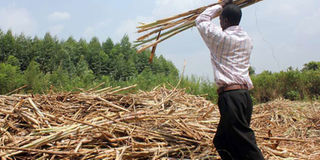It’s the magic bullet for cane farmers

A farmer sorts out dry sugarcane at a farm in Yiro Village, Siaya County, on February 10, 2016. It is time for a new paradigm shift in the development of raw materials for the success of the sugar industry. PHOTO | TONNY OMONDI | NATION MEDIA GROUP
What you need to know:
- The abolishment of zoning by the Agriculture and Food Authority has posed serious challenges to local millers.
- Reports indicate that the EU mostly produces beet sugar for 20 per cent of its market, for local consumption.
The expiry of European Union sugar quotas next month spells doom for the sugar sector locally and regionally.
The pact, which was signed some 45 years ago, limited the quantities of sugar that the EU could produce for local and external markets.
This will introduce a new dynamic between the European and global sugar markets.
COMESA
The Kenyan industry, which has been enjoying protection from the Common Market for Eastern and Southern Africa (Comesa) in order to reorganise itself for the expected no-holds-barred competition, will face even stiffer challenges from the extra sugar that will come from Europe.
The other big question is: How prepared are we in view of these challenges when the Comesa safeguard, recently extended for another two years, expires?
ZONING
The millers must begin to think of some ingenious ways out as they face a double-thronged competition.
Indeed, the abolishment of zoning by the Agriculture and Food Authority (AFA) has posed serious challenges to local millers.
It is time the millers did things differently as the end of the global and regional trade pacts is going to have a huge impact on the industry.
IRRIGATION
The real solution lies in irrigation. Even countries that get more rain than Kenya have embraced irrigation.
Companies such as Ominicane in Mauritius and Kenana in Sudan, which are among the top sugar producers, have embraced irrigation for sustainability.
This is why the pilot irrigation project recently launched by Water and Irrigation Cabinet Secretary Eugene Wamalwa in western Kenya must be seen as a deliberate effort to create a paradigm shift in cane farming.
SUSTAINABILITY
That countries with better rain distribution patterns have adopted irrigation is an indication that this is how to ensure sustainable milling.
This is where a coalition of like-minded partners will be required to provide long-term financing and grants because of the heavy capital needed.
Cane being a plantation crop, largely relies on the natural warm weather.
RAINFALL
But other factors such as soil type, cane variety, land preparation also matter in yields.
Quite critical is rain distribution.
A little water is required as cane nears harvest for better sucrose, yet our rains have made it a habit to pour heavily when all that is needed is a little or none at all for better yields, which can compete with the sugar that likely will find its way into our market soon.
QUALITY
This is where irrigation comes in. Nzoia Sugar Company, though on small scale, in partnership with Prochem, invested Sh10 million in four hectares to do furrow irrigation.
The results were impressive, including improved quality of seed cane and overall yields within the required time.
This must be replicated by other millers on a large scale.
Industries in Zambia, Swaziland, Sudan and Ethiopia have embraced irrigation as a guarantee for low TCTS (tonnes of cane to tonnes of sugar).
FINANCE
This is the time to scout for partners to provide funds for the most efficient, and not wasteful and cheaper irrigation.
Experts say that well-distributed rain enables cane to grow at one centimetre a day and thus be ready for harvesting in 10 months.
If Kenana and Omnicane can do it, why not us?
Without adequate raw material that has high sucrose content, it will be uneconomical to be in business as high recovery ratio means high operation costs, and little margins.
FARMERS
The resilience of cane puts it at a vantage position for irrigation by even small-scale farmers.
In India, farmers supply cane by handcarts because of irrigation.
Compelling factories to pay farmers according to the sucrose content as opposed to tonnage will shift focus to cane quality as opposed to tonnage, which at times, may give low recoverable sugar.
TRADE PACT
In Brazil, the ethanol produced is mixed with fuel when global oil prices are high, guaranteeing sale and farmers’ payments in time.
It is thus not surprising that Brazil is one of the world’s largest sugar producers!
Reports indicate that the EU mostly produces beet sugar for 20 per cent of its market, for local consumption.
The expiry of the trade pact means they will be self-sustaining.
BREEDING
The other scenario is that the extra sugar they produce will find its way here.
So either way, we shall be affected. Breeding of cane varieties such as D8484, and N14 by the Sugar Research Institute must be tailored towards irrigation, not just natural weather.
Cane being a tropical crop gives us an edge over Europe but it doesn’t provide miracles to those who do not develop it.
It is time for a new paradigm shift in the development of raw materials for the success of the sugar industry.
Mr Awino is a communications expert in the sugar industry. [email protected]




